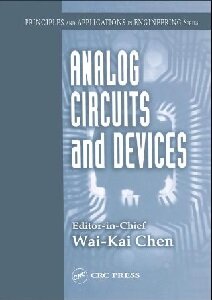 |
Облако тегов |
 |
 |
Circuit Cellar, Elektor, Everyday Practical Electronics, Nuts and Volts, антенна, Антенны, аудио, видео, Журнал, Измерения, источники питания, Микросхемы, приборы, Радіоаматор, Радио, Радио (жур.), Радиоаматор, Радиоконструктор, Радиолюбитель, радиолюбителю, Радиолюбителям, Радиомир, радиоприемник, радиосвязь, радиоэлектроника, ремонт, Ремонт и Сервис, Связь, Серия Ремонт, справочник, схема, Схемотехника, Схемы, Телевидение, Телевизоры, трансформаторы, усилитель, Электрик, Электроника, Электротехника
Показать все теги
|
 |
 |
 |
 |
 |
Авторские права |  |
 |
Все книги на сайте представлены исключительно в ознакомительных целях!
Авторам, желающим внести поправки, просим связаться с администрацией.
Администрация
|
 |
 |
 |
 |
|
 |
 |
Книги » Электроника: Analog Circuits and Devices
|
 |
 |
 Просмотров: 854 Просмотров: 854  добавил: MIHAIL62 добавил: MIHAIL62  30-07-2014, 20:26 30-07-2014, 20:26 
|
|

Название: Analog Circuits and Devices
Автор: Wai-Kai Chen
Издательство: CRC Press
Год: 2003
Страниц: 475
Язык: Английский
|
|
The Principles and Application in Engineering Series is a new series of convenient, economical references sharply focused on particular engineering topics and subspecialties. Each volume in this series comprises chapters carefully selected from CRC's bestselling handbooks, logically organized for optimum convenience, and thoughtfully priced to fit every budget. Extracted from the best-selling VLSI Handbook, Analog Circuits and Devices provides a comprehensive resource covering the spectrum of devices and their models. In addition to practical discussions on amplifiers, circuits and filters, and compound semiconductor digital integrated circuit technology, it also includes chapters on design automation, design languages, and algorithms and architectures.
Contents
1 Bipolar Junction Transistor (BJT) Circuits David J. Comer and Donald T. Comer
1.1 Introduction .........................................................................................................................1-1
1.2 Physical Characteristics and Properties of the BJT ..............................................................1-2
1.3 Basic Operation of the BJT....................................................................................................1-2
1.4 Use of the BJT as an Amplifier .............................................................................................1-5
1.5 Representing the Major BJT Effects by an Electronic Model ..............................................1-6
1.6 Other Physical Effects in the BJT .........................................................................................1-6
1.7 More Accurate BJT Models ..................................................................................................1-8
1.8 Heterojunction Bipolar Junction Transistors ......................................................................1-8
1.9 Integrated Circuit Biasing Using Current Mirrors ..............................................................1-9
1.10 The Basic BJT Switch ..........................................................................................................1-14
1.11 High-Speed BJT Switching .................................................................................................1-16
1.12 Simple Logic Gates ..............................................................................................................1-19
1.13 Emitter-Coupled Logic .......................................................................................................1-19
2 RF Passive IC Components Thomas H. Lee, Maria del MarHershenson,
Sunderarajan S. Mohan, Hirad Samavati, and C. Patrick Yue
2.1 Introduction .........................................................................................................................2-1
2.2 Fractal Capacitors .................................................................................................................2-1
2.3 Spiral Inductors ....................................................................................................................2-8
2.4 On-Chip Transformers .......................................................................................................2-14
3 CMOS Amplifier Design Harry W. Li, R. Jacob Baker, and Donald C. Thelen
3.1 Introduction ..........................................................................................................................3-1
3.2 Biasing Circuits .....................................................................................................................3-7
3.3 Amplifiers ...........................................................................................................................3-15
4 Bipolar Amplifier Design Geert A. De Veirman
4.1 Introduction .........................................................................................................................4-1
4.2 Single-Transistor Amplifiers ................................................................................................4-1
4.3 Differential Amplifiers ........................................................................................................4-22
4.4 Output Stages ......................................................................................................................4-40
4.5 Bias Reference .....................................................................................................................4-45
4.6 Operational Amplifiers .......................................................................................................4-49
4.7 Conclusion ..........................................................................................................................4-56
5 High-Frequency Amplifiers Chris Toumazou and Alison Payne
5.1 Introduction .........................................................................................................................5-1
5.2 The Current Feedback Op-Amp ..........................................................................................5-2
5.3 RF Low-Noise Amplifiers ...................................................................................................5-12
5.4 Optical Low-Noise Preamplifiers .......................................................................................5-18
5.5 Fundamentals of RF Power Amplifier Design ...................................................................5-24
5.6 Applications of High-Q Resonators in IF-Sampling Receiver Architectures ....................5-29
5.7 Log-Domain Processing .....................................................................................................5-36
6 Operational Transconductance Amplifiers R.F. Wassenaar, Mohammed Ismail, and
Chi-Hung Lin
6.1 Introduction .........................................................................................................................6-1
6.2 Noise Behavior of the OTA ..................................................................................................6-1
6.3 An OTA with an Improved Output Swing ..........................................................................6-4
6.4 OTAs with High Drive Capability.........................................................................................6-6
6.5 Common-Mode Feedback .................................................................................................6-14
6.6 Filter Applications with Low-Voltage OTAs ......................................................................6-16
7 Nyquist-Rate ADC and DAC Bang-Sup Song
7.1 Introduction ..........................................................................................................................7-1
7.2 ADC Design Arts ...................................................................................................................7-5
7.3 ADC Architectures ................................................................................................................7-7
7.4 ADC Design Considerations ...............................................................................................7-18
7.5 DAC Design Arts .................................................................................................................7-22
7.6 DAC Architectures ..............................................................................................................7-23
7.7 DAC Design Considerations ...............................................................................................7-27
8 Oversampled Analog-to-Digital and Digital-to-Analog Converters
John W. Fattaruso and Louis A. Williams, III
8.1 Introduction ..........................................................................................................................8-1
8.2 Basic Theory of Operation ....................................................................................................8-2
8.3 Alternative Sigma-Delta Architectures ...............................................................................8-14
8.4 Filtering for Sigma-Delta Modulators.................................................................................8-19
8.5 Circuit Building Blocks .......................................................................................................8-21
8.6 Practical Design Issues.........................................................................................................8-30
8.7 Summary.............................................................................................................................8-36
9 RF Communication Circuits Michiel Steyaert, Marc Borremans, Johan Janssens, and
Bram De Muer
9.1 Introduction ..........................................................................................................................9-1
9.2 Technology ............................................................................................................................9-2
9.3 The Receiver ..........................................................................................................................9-4
9.4 The Synthesizer....................................................................................................................9-12
9.5 The Transmitter...................................................................................................................9-17
9.6 Toward Fully Integrated Transceivers.................................................................................9-25
9.7 Conclusions .........................................................................................................................9-25
10 PLL Circuits Min-shueh Yuan and Chorng-kuang Wang
10.1 Introduction ........................................................................................................................10-1
10.2 PLL Techniques ...................................................................................................................10-2
10.3 Building Blocks of the PLL Circuit....................................................................................10-18
10.4 PLL Applications ...............................................................................................................10-22
11 Continuous-Time Filters John M. Khoury
11.1 Introduction ........................................................................................................................11-1
11.2 State-Variable Synthesis Techniques...................................................................................11-2
11.3 Realization of VLSI Integrators...........................................................................................11-9
11.4 Filter Tuning Circuits ........................................................................................................11-25
11.5 Conclusion........................................................................................................................11-30
12 Switched-Capacitor Filters Andrea Baschirotto
12.1 Introduction ........................................................................................................................12-1
12.2 Sampled-Data Analog Filters...............................................................................................12-2
12.3 The Principle of the SC Technique .....................................................................................12-4
12.4 First-Order SC Stages ..........................................................................................................12-6
12.5 Second-Order SC Circuit ....................................................................................................12-9
12.6 Implementation Aspects....................................................................................................12-14
12.7 Performance Limitations...................................................................................................12-18
12.8 Compensation Technique (Performance Improvements)...............................................12-22
12.9 Advanced SC Filter Solutions............................................................................................12-27
13 Materials Stephen I. Long
13.1 Introduction ........................................................................................................................13-1
13.2 Compound Semiconductor Materials ................................................................................13-1
13.3 Why III-V Semiconductors?................................................................................................13-2
13.4 Heterojunctions..................................................................................................................13-3
14 Compound Semiconductor Devices for Digital Circuits Donald B. Estreich
14.1 Introduction ........................................................................................................................14-1
14.2 Unifying Principle for Active Devices: Charge Control Principle......................................14-1
14.3 Comparing Unipolar and Bipolar Transistors....................................................................14-6
14.4 Typical Device Structures..................................................................................................14-13
15 Logic Design Principles and Examples Stephen I. Long
15.1 Introduction ........................................................................................................................15-1
15.2 Static Logic Design ..............................................................................................................15-1
15.3 Transient Analysis and Design for Very-High-Speed Logic...............................................15-8
16 Logic Design Examples Charles E. Chang, Meera Venkataraman, and Stephen I. Long
16.1 Design of MESFET and HEMT Logic Circuits ...................................................................16-1
16.2 HBT Logic Design Examples.............................................................................................16-10
Ключевые теги: Analog, Circuits
|
|
Содержание  Оглавление Оглавление
|
|
|
|
|
|
|
|
Другие новости по теме:
|
|
|
|
 |
 |
|
 |
|
 |
Информация |
 |
 |
 |
Посетители, находящиеся в группе Гости, не могут оставлять комментарии к данной публикации. |
 |
 |
 |
 |
|
 |
|

